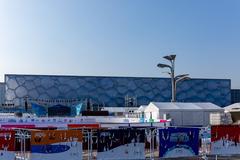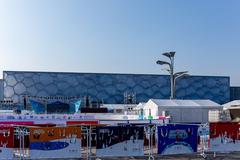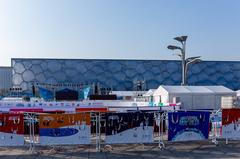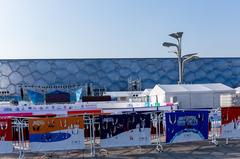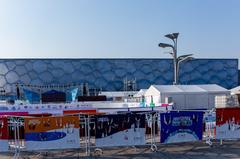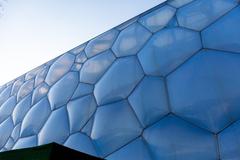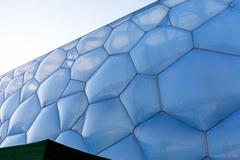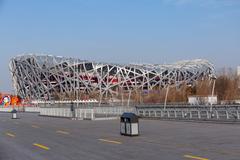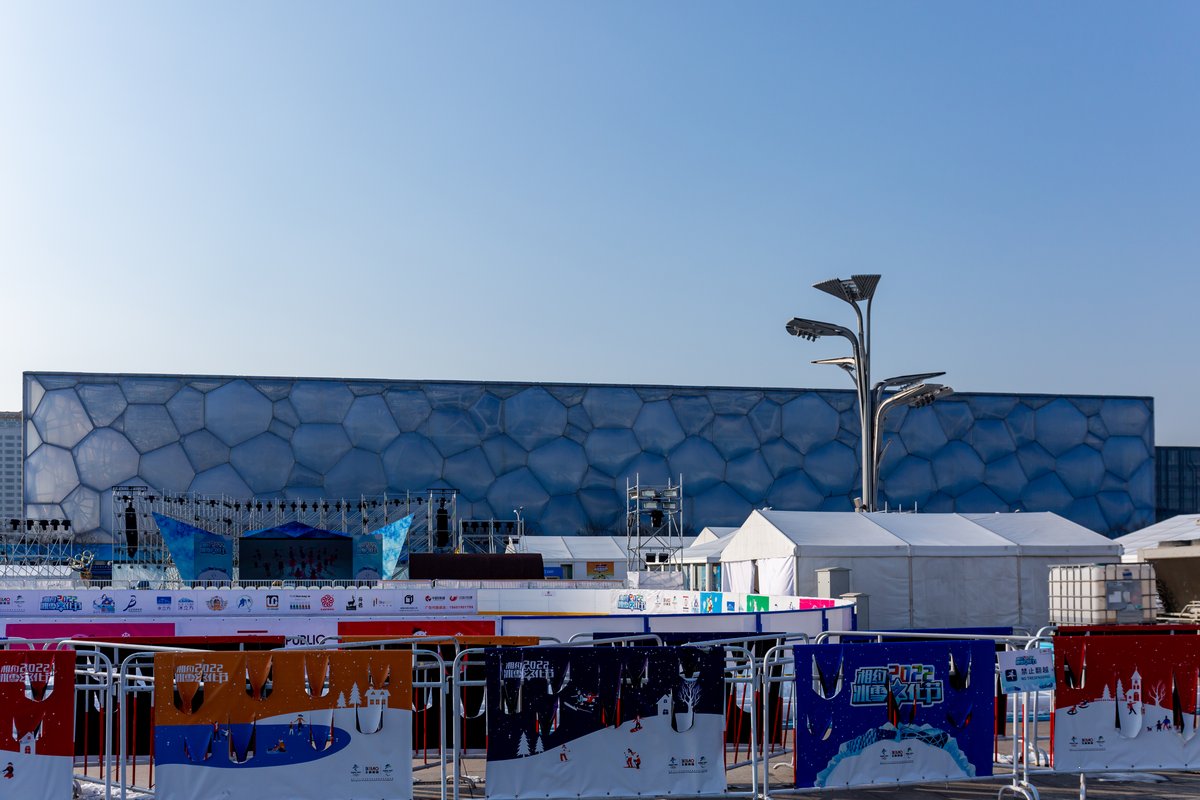
Beijing National Aquatics Center (Water Cube) – Visiting Hours, Tickets, and Attractions Guide
Date: 14/06/2025
Introduction
The Beijing National Aquatics Center, commonly known as the “Water Cube” (水立方), stands as a dazzling embodiment of modern architectural achievement and cultural heritage in China’s capital. Originally constructed for the 2008 Summer Olympics, this landmark has since evolved into a multifaceted venue, welcoming millions of visitors each year. The Water Cube’s bubble-like façade, inspired by the natural geometry of soap foam, is both a feat of engineering and a reflection of Chinese cosmological philosophy—contrasting the square (Earth) of the Water Cube with the circle (Heaven) of the neighboring Bird’s Nest Stadium. Today, the Water Cube offers a blend of history, leisure, and innovation through its transformation into Asia’s largest indoor waterpark and its continued role in major sporting and cultural events.
Whether you’re drawn by its Olympic legacy, stunning design, or family-friendly attractions, this guide delivers everything you need to plan an unforgettable visit: detailed historical context, ticketing and access information, travel tips, and highlights of nearby Beijing attractions (Wikipedia, Facadeworld, Aqua Magazine).
Historical Background & Architectural Significance
Conception and Design
Initiated through an international design competition in 2003, the Water Cube’s winning concept was a collaborative effort between PTW Architects (Australia), Arup, China State Construction Engineering Corporation (CSCEC), and China Construction Design International (CCDI) (Facadeworld). The team’s vision drew inspiration from the random-yet-ordered structure of foam bubbles, mathematically realized through the Weaire–Phelan geometry, which provided both visual dynamism and structural efficiency.
Symbolism and Structure
The Water Cube’s square footprint complements the circular Bird’s Nest Stadium, symbolizing the ancient Chinese cosmological belief in a square Earth and round Heaven. Its three-dimensional steel space frame, clad in 3,065 ETFE (ethyl tetrafluoroethylene) “bubble” pillows, is both lightweight and robust, offering earthquake resistance and unique daylighting effects (World Construction Network).
Olympic Legacy
Completed in January 2008, the Water Cube hosted all swimming, diving, and synchronized swimming events during the 2008 Summer Olympics and Paralympics. It was the site of 25 world records and provided seating for 17,000 spectators (Topend Sports). Its innovative design optimized athlete performance and set new standards for aquatic venues.
Post-Olympic Transformation & Dual Functionality
Adaptive Reuse and Happy Magic Water Park
Following the Olympics, the Water Cube underwent a significant renovation, opening the Happy Magic Water Park in 2010 (Aqua Magazine). The western half of the building was transformed into Asia’s largest indoor waterpark, featuring:
- A giant wave pool and lazy river
- Multiple thrilling water slides, including a transparent freefall drop
- Interactive children’s play zones
- Year-round climate control for comfort in all seasons
Continued Sporting Excellence
The eastern section retains Olympic-standard pools and diving facilities, regularly hosting:
- National and international aquatic competitions
- Elite athlete training
- Public swimming (separate ticketing applies)
The “Ice Cube” – 2022 Winter Olympics
In a world-first, the Water Cube was adapted into the “Ice Cube” for curling competitions during the 2022 Winter Olympics (BSAM). This transformation underlines the venue’s adaptability and Beijing’s unique Olympic legacy as a host of both Summer and Winter Games.
Cultural and Community Events
The Water Cube also serves as a venue for:
- Concerts and art exhibitions
- Corporate and community events
- Educational programs and cultural festivals
Environmental Sustainability
From inception, environmental stewardship was central to the Water Cube’s design:
- ETFE cladding allows abundant daylight and provides insulation, reducing lighting and heating needs by up to 55% (World Construction Network).
- Water recycling systems reclaim up to 80% of collected water for irrigation and flushing.
- Solar energy is used to heat pools and interiors, and heat recovery systems optimize climate control.
These features earned the Water Cube international recognition for sustainable sports architecture (BSAM).
Visiting the Water Cube: Practical Information
Visiting Hours
- General Opening: Daily, 09:00 – 21:00 (hours may vary on holidays or during events; always check the official site before visiting).
Ticket Types & Pricing
- General Admission: 30-50 RMB (approx. $4.50–$7.50 USD)
- Happy Magic Water Park: 120-200 RMB (approx. $18–$30 USD)
- Swimming Only: 50 RMB (approx. $7.50 USD)
- Discounts: Available for children, seniors, and students.
- Ticket Purchase: On-site or via the official website; bundled tickets with the Bird’s Nest are sometimes available (Tour-Beijing.com).
Accessibility
- Wheelchair-accessible entrances, ramps, and elevators
- Accessible restrooms and seating
- Family facilities: stroller rentals, nursing rooms
Getting There
- Subway: Line 8 to Olympic Green Station (Exit B1/B2); the venue is a short walk away
- By Bus/Taxi: Several routes serve the Olympic Green area
Facilities & Amenities
- Changing rooms and lockers
- Cafés and snack bars
- Souvenir shops with Olympic-themed merchandise
- English signage and available guided tours in multiple languages
Nearby Attractions & Travel Tips
- Bird’s Nest National Stadium: Iconic neighbor, renowned for its steel lattice design
- Olympic Forest Park: Expansive green space for walking, jogging, and relaxation
- China Science and Technology Museum: Interactive exhibits for all ages
- Olympic Observation Tower: Panoramic views of the Olympic Green
Travel Tips:
- For a quieter experience, visit early mornings or on weekdays.
- Don’t miss the Water Cube’s illuminated façade at night—ideal for photography.
- Check swimming pool and water park schedules to avoid closures for events or training.
Special Events and Programs
- Guided Tours: Available with in-depth insights into the architecture and Olympic history (advance booking recommended)
- Cultural & STEM Events: Includes exhibitions, educational programs, and the annual “Light It Blue” autism awareness campaign
- International Sports: Hosts ongoing aquatics competitions and youth development programs
Frequently Asked Questions (FAQ)
Q: What are the Water Cube’s visiting hours?
A: Generally 09:00–21:00 daily; verify hours during holidays or special events.
Q: How can I purchase tickets?
A: Tickets are available online via the official website and on-site at ticket counters.
Q: Is the venue accessible for people with disabilities?
A: Yes, with ramps, elevators, and accessible restrooms throughout.
Q: Are guided tours available?
A: Yes, tours in Chinese and English can be booked online or on-site.
Q: What other attractions can I visit nearby?
A: Bird’s Nest Stadium, Olympic Forest Park, the China Science and Technology Museum, and Olympic Observation Tower.
Q: Can I swim inside the Water Cube?
A: Yes, the public swimming area is open to visitors with a separate ticket.
Visuals and Interactive Resources
Summary and Visitor Tips
The Water Cube is a vibrant testament to Beijing’s Olympic spirit, blending visionary design, sustainable engineering, and dynamic cultural activity. Its transformation from an Olympic venue to a world-class waterpark and community hub ensures its ongoing relevance and appeal. Located in the heart of Olympic Green, with easy transit connections and proximity to other major attractions, the Water Cube offers a unique mix of recreation, architecture, and history.
Visitor Tips:
- Confirm opening hours and ticket options before your visit.
- Make use of public transportation for convenience.
- Take advantage of guided tours for a richer understanding of the venue.
- Combine your visit with neighboring attractions for a full day in Olympic Green.
For continued updates on events, ticketing, and travel tips, download the Audiala app and follow relevant social media platforms.
Sources
- Wikipedia – Beijing National Aquatics Center
- Facadeworld – Water Cube Beijing
- Aqua Magazine – Beijing’s Water Cube 10 Years Later
- Tour-Beijing.com – How to Visit Bird’s Nest and Water Cube
- World Construction Network – Watercube Aquatic Centre
